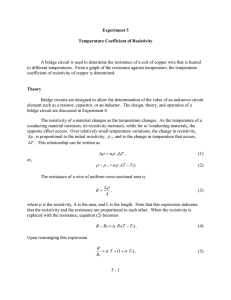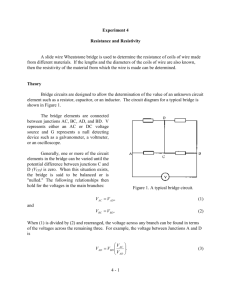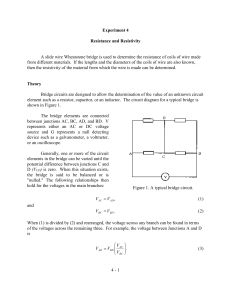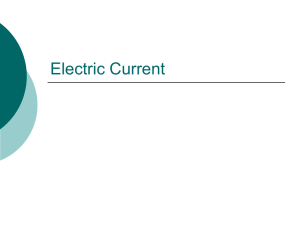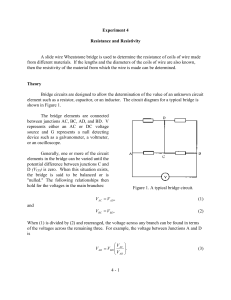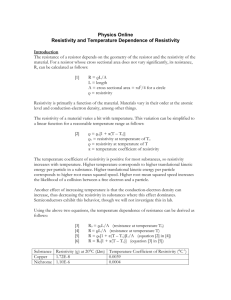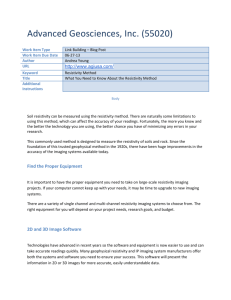Theory
advertisement
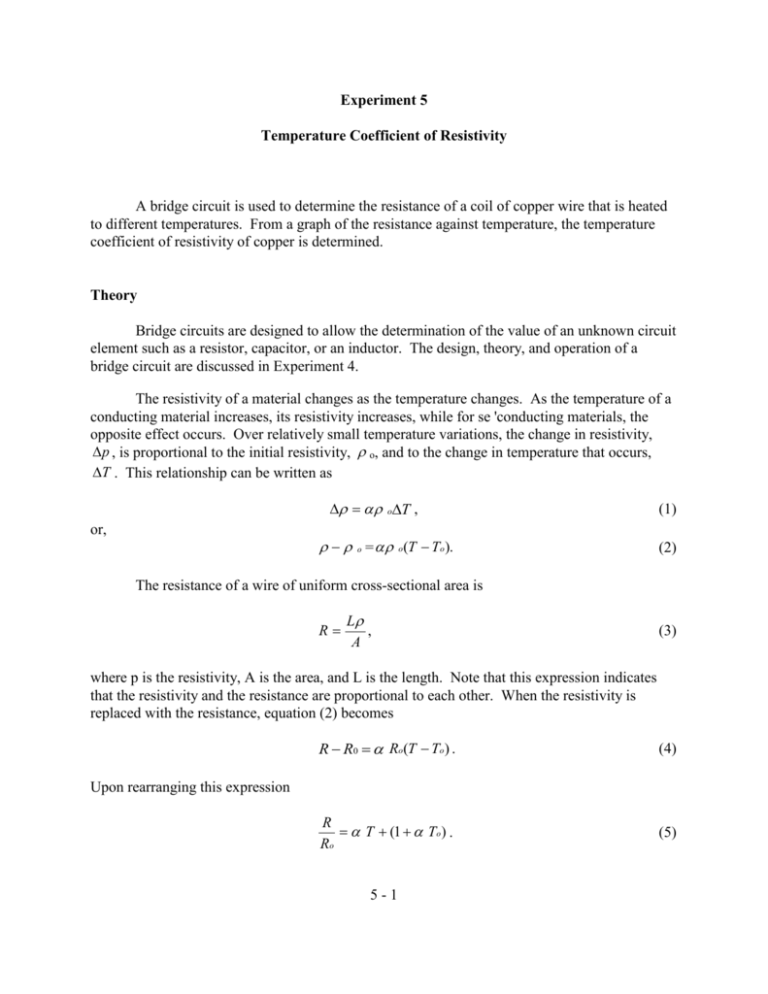
Experiment 5 Temperature Coefficient of Resistivity A bridge circuit is used to determine the resistance of a coil of copper wire that is heated to different temperatures. From a graph of the resistance against temperature, the temperature coefficient of resistivity of copper is determined. Theory Bridge circuits are designed to allow the determination of the value of an unknown circuit element such as a resistor, capacitor, or an inductor. The design, theory, and operation of a bridge circuit are discussed in Experiment 4. The resistivity of a material changes as the temperature changes. As the temperature of a conducting material increases, its resistivity increases, while for se 'conducting materials, the opposite effect occurs. Over relatively small temperature variations, the change in resistivity, p , is proportional to the initial resistivity, o, and to the change in temperature that occurs, T . This relationship can be written as oT , or, o = o (T To ). (1) (2) The resistance of a wire of uniform cross-sectional area is R L , A (3) where p is the resistivity, A is the area, and L is the length. Note that this expression indicates that the resistivity and the resistance are proportional to each other. When the resistivity is replaced with the resistance, equation (2) becomes R R0 Ro(T To) . (4) R T (1 To ) . Ro (5) Upon rearranging this expression 5-1 This is the equation of a straight line on a graph of temperature, T, versus the ratio of resistances, R/Ro. According to the equation, the temperature coefficient of resistivity can be found from the slope and from the value of the, y-intercept. The values for the temperature coefficient are (slope), and (6) (intercept ) 1 To (7) In order to make accurate determinations of the resistance of the copper coil, a bridge circuit is used as described in Experiment 4. When the circuit elements are connected as shown in Figure 1, the value of the unknown resistance connected between junctions A and D is R AD RBD R . 10 R Figure 1. Schematic of the Wheatstone bridge. Apparatus o o o o Potentiometer DC power supply Galvanometer Standard resistance box, ±0.2% 5-2 o o o o Coil of copper wire in beaker Thermometer Hotplate 5 leads Procedure 1) Connect the Wheatstone bridge circuit with the standard resistance box between junctions B and D and the coil of copper wire of unknown resistance between junctions A and D. Fill the beaker with oil ensuring that the coils of copper wire are covered. Place the beaker on the hot plate. Allow the system to come to thermal- equilibrium, then measure the temperature of the oil. Record this temperature as To. 2) Turn on the DC power supply and adjust the voltage knob for some intermediate value. 3) Set the dial on the potentiometer to the 5.00 reading. 4) Depress YEY 1, 5 VOLTS button on the galvanometer. Pull and replace the plugs on the resistance box until the galvanometer needle is zeroed or nearly zeroed. Now depress KEY 2, 0.1 VOLTS button and again pull and replace the plugs until the needle is zeroed or nearly zeroed. Finally, depress the most sensitive button (KEY 3-GALV) and again attempt to zero the reading by adjusting the resistance box. CAUTION: If the most sensitive button (KEY 3-GALV) is depressed first, too much current may flow through the galvanometer causing it to bum out. 5) Hold the most sensitive button (KEY 3-GALV) depressed, and turn the dial on the potentiometer until the galvanometer is zeroed. Record this value as the reading on the potentiometer. 6) Slowly heat the oil in the beaker. Stir the oil with the stirring rod to ensure the heat is being evenly distributed. Continue to heat until the temperature of the system increases above the starting temperature by approximately 10 C'. Record the temperature, and use the bridge to find the resistance of the coil of wire. 7) Continue heating and taking measurements at 10 Co increments until you reach a temperature of approximately 80oC. (Do not exceed this temperature.) Analysis Use (8) to calculate the resistance values of the copper coil at the various temperatures. Include these values, the temperature values, and the ratio R/Ro, in a table. Graph R/Ro, against T from the starting temperature to the ending temperature. Draw a straight line that best fits the data points. Find the slope of the graph and the y-intercept value, and from these calculate the temperature coefficient of resistivity of copper using (6) and (7). Include these values in a table together with the book value and the percentage errors. 5-3 Conclusions Explain what factor(s) caused the greatest errors in your determination of the temperature coefficient of resistivity, and why. Do your results seem to indicate the presence of these sources of error? Questions 1. Why does the resistivity of a conductor increase when the temperature increases? 2. Why does the resistivity of a semiconductor decrease when the temperature increases? 5-4
